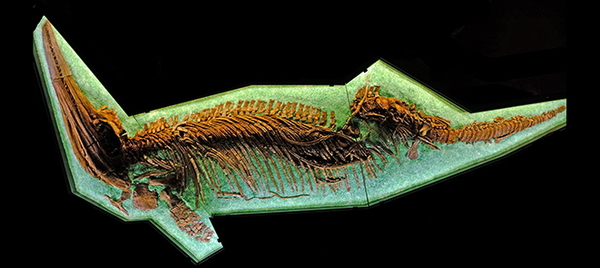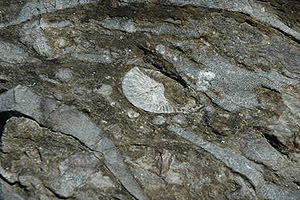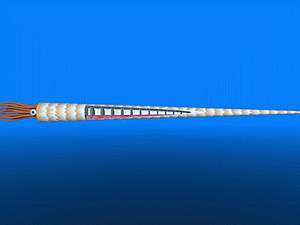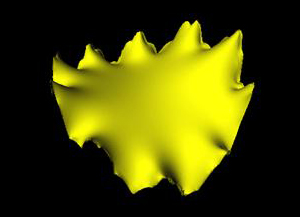Available master projects Spitsbergen Mesozoic Research Group (SMRG)
SMRG are currently working on describing material from the Early-Middle Triassic of Svalbard, and we have many projects available for master students . We are happy to discuss other opportunities, so do not hesitate to contact Aubrey Roberts a.j.roberts@nhm.uio.no or Jørn Hurum j.h.hurum@nhm.uio.no if you have questions or wish to apply for the projects. Projects are noted as being either more biology or geology focused, this is a guideline and not a background requirement. Read more about our Svalbard project(s).
We are an open and welcoming group and we are very happy to adapt projects to individual needs or wants. Some projects require fieldwork, others only lab work. For fieldwork, prior outdoor experience in mountainous terrain or in the Arctic is required due to HSE risks in remote areas.

We are currently offering the following master projects:
- Description of the Synechondiform material from the Early Triassic Grippia level bone bed (Biology focused)
Synechondiform sharks have been described from the Early Triassic of Spitsbergen (Bratvold et al., 2018, Norwegian Journal of Geology 98) and likely represent at least one new taxon. This project involves examining the collections for new material of synchondiformes and determine whether these represent a new taxon or if it can be referred to a known genus/species.
- Preliminary description of the bony fish material from the Early Triassic Grippia level bone bed (Biology focused)
The material from the Grippia bone bed includes a vast amount of Osteichthyes material. This project will provide the preliminary research needed to determine the type and number of taxa present in the Grippia bone bed. Statistical approaches will be utilised to examine the structure of the ecosystem.
- Description and taxonomy of Middle Triassic mixosaurid ichthyosaurs from Svalbard. (Biology focused)
Multiple mixosaurid ichthyosaur specimens have been collected from the Botneheia Fm. of Svalbard. Methods for acid and physical preparation developed at the NHM (UiO) will be utilised by the candidate to allow for in-depth description of the material. The aim will be to use these specimens to redescribe the Mixosauridae family and identify diagnostic features of the two genera Mixosaurus and Phalarodon. Experience with phylogenetic analyses is recommended, but not required.
- Depositional environment and description of micro- bone beds from the Early and Middle Triassic of Svalbard. (Geology focused)
Layers of “fish hash” have been discovered overlying bone beds in Spitsbergen. These include a large amount of small bones, teeth and scales from predominantly bony fish and chondrichthyans. The aim of this project is to discuss the sedimentology and depositional environment of the “fish hash” layers, and to conduct a comparison of the deposition and preservation of the Early and Middle Triassic deposits. This project requires some experience with sedimentology.
- Description of micro vertebrate fossils from the bone beds from the Early and Middle Triassic of Svalbard. (Biology focused)
Layers of “fish hash” have been discovered overlying bone beds in Spitsbergen. These include a large amount of small bones, teeth and scales from predominantly bony fish and chondrichyians. The aim of this project is to describe the fauna present in these layers and compare differences and similarities in faunal composition between the Early and Middle Triassic “fish hash” layers.
- Palaeopathology and evidence of feeding behaviors in Triassic marine reptiles. (Biology focused)
In the Early Triassic Grippia bone bed, numerous bone elements have been recovered indicating feeding behaviour and/or evidence of healing from injuries. The aim of this project is to describe the material and discuss the causes and implications this may have on the palaeobiology and palaeoecology of the ecosystem. Micro-CT scanning will be used for this project. The student will be expected to acquire the necessary skill set for working with computed tomography data.
- Palynology and isotope stratigraphy from the Early Triassic successions on Svalbard and correlation with previous studies. (Geology focused)
The student will describe the sedimentology of the Early Triassic to further our understanding of the palaeoenvironment. . The project includes fieldwork to collect and analyse sediment samples from our field areas in west Spitsbergen and correlate these using isotope analysis to known and published results in the Boreal Sea as well as globally.
Other possible projects
We also have several specimens of Late Jurassic marine reptiles from Svalbard that could be used for descriptive and taxonomy-based master projects (Ichthyosaurs and Plesiosaurs). Many of these specimens will require a large amount of preparation work, feel free to contact Aubrey or Jørn if this is of interest.
Marine faunas in the Holocene of the Oslofjord area – climate, sea level, faunal invasion
Marine sediments of the Holocene (last 10,000 years) in the Oslofjord area are now widely exposed on land because of relative drop in sea level. These clays and sands are rich in well-preserved fossils of bivalves, gastropods and other invertebrates, recording dramatic changes in climate, sea level and ecology through time. These faunas have not been extensively studied for more than a hundred years (Brøgger 1901). Since then, our understanding of Holocene climate and ecology has increased enormously, and methods have vastly improved regarding e.g. radiocarbon dating, geochemistry for climate reconstruction, and ecological and stratigraphic data analysis.
We believe that the Holocene marine faunas in the Oslofjord area can provide a fruitful field of research into the ecology of environmental change. Since the taxa are the same as in our time, the Holocene data can be used as good analogues for modern processes, and possibly inform predictions about marine faunal responses to anthropogenic warming, sea level rise and faunal invasion such as that of the Pacific oyster.
We need several MSc students (biology or geology) to carry out a pilot study, giving you a unique opportunity to open up a new area of research. Old localities must be rediscovered, so some treasure hunting will be required! Projects include:
1. The Preboreal invertebrate faunas of the Oslofjord area
This project will focus on the first invertebrates to colonize the area after the ice cap receded, especially the bivalves, crustaceans and foraminifera near the so-called “marine limit”, i.e. the locally highest sea-level during deglaciation. What can the taxonomic composition of the faunas (often with Mytilus and barnacles), size distributions, sediment properties and geochemistry tell us about the early Holocene succession during rapid climatic warming and sea-level drop? The material will come from field work at localities around Oslo as well as from museum collections. The data will be used for ecological data analysis, especially ordinations and diversity analysis, and some biogeographical analysis and plotting (GIS).
2. The late Atlantic shallow-water oyster banks of the Oslofjord area
Throughout the Oslofjord area, mollusc faunas rich in oysters (“oyster banks”) are found ca. 10-40 meters above present sea level. Preliminary radiocarbon dating indicates that at least some of these are from late Atlantic time (ca. 4,000 BC), i.e. during the warm “climatic optimum” of the Holocene. The project will focus on the ecology of these oyster banks, with field and laboratory work. Possible localities include low-lying areas around Oslo (e.g. Slemmestad and Malmøya), and Hvaler ca. 100 km south of Oslo. Associated fossils will also be collected and identified for ecological data analysis. Are these oyster banks all of similar age, recording an event of regional significance? Do they represent a faunal invasion? We would also like to look at age distributions, shape variation etc. Encrusting and infestation (polychaete tubes and burrows, sponge borings, etc.) will be studied with microfocus CT.
3. Seawater paleotemperatures of the Holocene in the Oslofjord area
The student will attempt to estimate seawater temperatures using classical geochemical and paleoecological techniques applied to the fossil faunas. This will include oxygen isotope analysis (clumped isotopes may be attempted, depending on funding), Mg/Ca and Sr/Ca ratios, and comparing fossil assemblages with present-day faunas. We may also attempt reconstruction of paleosalinity using e.g. Ba/Ca ratios.
Kontaktperson: Øyvind Hammer
Paleoøkologi i Braksøyaformasjonen, silur, Oslofeltet

Koraller og svamper i Braksøyaformasjonen, Kapitelberget, Skien. Foto Sven Dahlgren
Braksøyaformasjonen er en meget fossilrik kalkstein som har vært tolket som fossile ”patch”-rev. Gode lokaliteter finnes bl.a. på Ringerike og ved Skien. Det har vært gjort en del taksonomiske arbeider på bl.a. koraller i denne formasjonen, og også sedimentologi, men hittil ingen økologiske studier hvor man tar for seg faunaen som helhet.
Oppgaven vil bestå i detaljert datainnsamling og kartlegging i felt, fotografering, preparering og identifisering, samt statistisk analyse med henblikk på artssammensetning og biodiversitet. Er det mulig å identifisere økologiske soner innenfor hver struktur (inter-rev, revfront, revtopp, lagune)? Hvordan er disse relatert til dyp, lys og energi? Kan det identifiseres suksesjoner, dvs. konsistente rekkefølger av av kolonisering? Finnes det trender på større skala (Ringerike-Porsgrunn)?
Oppgaven egner seg for en biologi- eller geologistudent med interesse for marinbiologi, økologi eller paleontologi.
Kontaktperson: Øyvind Hammer
Hydrostatikk og ontogenese hos endoceratider

Modell av endoceratid cephalopode, med utskjæring som viser septer og sifo. Ill: Øyvind Hammer
Blekkspruter med rett skall er viktige og vanlige fossiler, med mange beskrevne arter. Det har vært vanlig å forestille seg at disse svømte med skallet horisontalt, men det har nylig blitt klart at en vertikal orientering er mer sannsynlig hos en del former. Likevel tror vi fortsatt at bl.a. endoceratidene, som var vanlige i ordovicium, svømte horisontalt. Dette er basert på spesielle morfologiske trekk hos denne gruppen. Er dette korrekt? Hvilken rolle spilte opplagring av ”ballastmateriale” under veksten?
Oppgaven består i studier på fossilt materiale, og enkel matematisk modellering av balanse og oppdrift. Dette vil innebære noe programmering. Tilsvarende arbeid gjøres for øyeblikket for andre fossile cephalopoder av en gruppe i Sveits, og samarbeid med disse vil være naturlig.
Oppgaven egner seg for en biologi- eller geologistudent med litt interesse for matematikk.
Kontaktperson: Øyvind Hammer
Lokal veksthastighet i septer i ammonoideer – ontogenetiske og fylogenetiske konsekvenser

Modell av septe (kammerskillevegg) fra ammonitt. Ill: Øyvind Hammer
Ammonoideer er utdødde cephalopoder som betraktes som modellorganismer i studier av evolusjon, på grunn av stor artsrikdom, hurtig evolusjon og gode fossile data. Septene (kammerskilleveggene) er kompliserte, og følger interessante ontogenetiske og fylogenetiske trender.
Oppgaven består i preparering av fossiler, morfometrisk oppmåling (laserscanner eller koordinatmålemaskin), og beregning av lokal veksthastighet. Tolkning med henblikk på sammenhenger mellom ontogenese og fylogenese (heterokroni). Prosjektet vil kunne innebære samarbeid med en forskningsgruppe i Sveits.
Studenten bør ha noe bakgrunn i informatikk, og gjerne interesse for 3D datagrafikk.
Kontaktperson: Øyvind Hammer
”Geologiske” oppgaver
Syklostratigrafi i ordovicium, Oslofeltet
Fra mange steder i verden, og fra mange geologiske tidsperioder, er det nå beskrevet syklisitet i sedimentære bergarter som kan tilskrives astronomiske pådrag (Milankovitsj-sykler). Dette gir oss et uhyre kraftig stratigrafisk verktøy for datering og korrelasjon. Slike sykler har vært foreslått men aldri undersøkt for en del formasjoner i ordovicium i Oslofeltet (spesielt Vollenformasjonen).
Oppgaven vil bestå i visuell logging av vekslende skifer- og kalksteinslag i Oslo-området, og kjernemateriale fra Langesund-området. Dette kan eventuelt understøttes av geofysiske logger (magnetisk susceptibilitet) og geokjemi (karbonatinnhold). Påfølgende statistisk analyse vil innebære tidsserie-metoder som spektralanalyse og wavelet-analyse.
Kontaktperson: Øyvind Hammer
Relevante paleontologiske kurs:
- GEO3030 - Livets utvikling
- GEO2160 - Paleontologi og paleoøkologi
- GEO4214 – Palynology, Palaeobotany and Palaeoclimatology
- GEO4212 - Paleozoologi, systematikk og evolusjon
Relevante biologikurs:
Prøv også kurskatalogen for geofag og biofag dersom pekerne til de enkelte kursene ikke fungerer. Litt informasjon for skoleelever som vurderer en utdannelse innen geologi.